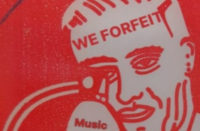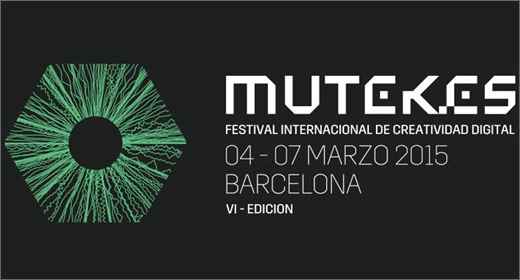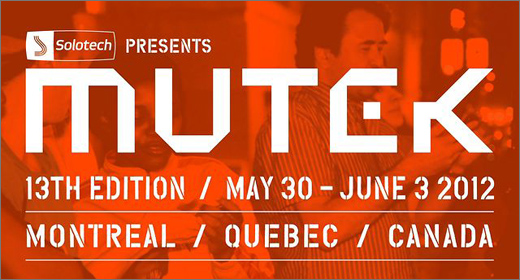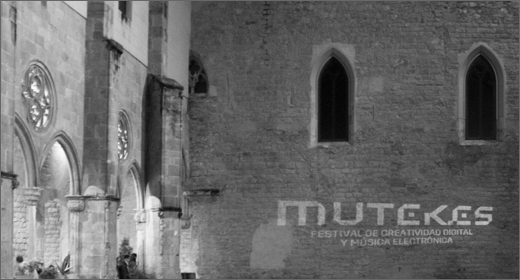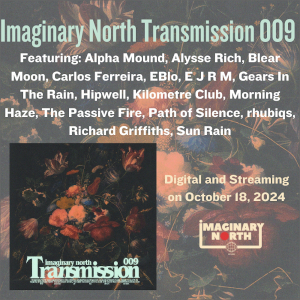::..:::…..:..::….:::::..:::..:::::::……:::…::.:::….::::..:..:::…::…….::::
Bienvenue from Montreal, Quebec!

June 2-6, 2004: ONCE again, the organizers, namely Alain Mongeau (Artistic Director) and Eric Mattson (Co-Curator), along with a strong supporting cast of staff and advisors have succeeded in pulling off a full-on, high quality cultural event of sonic audio/visual exploration. In doing so, this event has become the establishment of like international showcases that engage, entertain and make many question the futuristic possibilities of what links our ears to the physical manifestation of the live experience. In its fifth anniversary year Mutek brought together some highlights of former festivals (Raster-Noton showcase, Plastikman) and added a batch of emerging talent (kptmichigan, Skoltz_Kolgen, Portable). These practitioners of all things aural wielded laptops, toys, and a variable assortment of instruments both known and invented, creating environments that riveted audiences with bent beats and driven decibels.
Settled into the wondrously creative flow of one of North America’s finest cities cast in old world flair while constantly pushing the edge of contemporary art. Well, yes, there were still some unusual sites like the tragic faux-hawks still worn by many younger men, and the quizzical attire of the fashion needy, but these sightings were far and few between the important notes that would be played over these coming five days. Somehow the festival continues to maintain a distinct level of intimacy that is refreshing for such a cross pollination of diverse international players and the throngs that came for the musical merriment.

Fortunate for all, the much needed support to make these festivities a reality came from generous major sponsors such as Ex-Centris, the Goethe-Institut, ZED-TV, SAT and many other forward thinking media like XLR8R, Grooves and Parachute, righteous technology partners like Moog, Nikon, Ableton and Sennheiser and the continuous outpouring of Canadian governmental institutions along with many others. They cannot go without being acknowledged as they fuel the in and outputs of our hunger for work that breaks barriers and tries the imagination. The five day event boasted over 50 live performances, Mutek Intersection – a series of question/answer panels and workshops, Piknic Electronik – a picnic in the park with only the guidance of various well-spun DJs and the sunshine keeping you company; and lots of creative dialogue and interaction.
::..:::…..:..::….:::::..:::..:::::::……:::…::.:::….::::..:..:::…::…….::::

As for Mutek Intersection, the series of panels there were many highlights to mention, much broadcast live on ZED-TV. The first few panels were presented exclusively in French and dealt primarily with cultural politics and diversity of the avant-garde in Quebec. These occurred the day prior to the festival kick-off while I was stopped at the border crossing as one of the passengers aboard the bus I was on was interrogated for over 90 minutes and never made it back on board. Hmmmm, curious. Upon arrival, my wonderful host Francis greeted me at the main bus terminal after waiting an extra hour in the pouring rain, which we waded through to get to Mutek central – THIS is why friends are so important. We settled in, got a bite to eat and called it an early night.
At the following day’s opening panel Digital Culture Beyond Music, critic, grad student and moderator Tobias c. van Veen did an outstanding job hosting an excellent panel of knowledgeable participants including Recombinant Labs’ Naut Humon, Eric Dalbin who co-founded the Logistic label and will launch his new Dalbin DVD label later this year, the slightly tardy Carsten Nicolai (Raster-Noton) and Matt Laszuk of Iris Distribution. The premise of this talk was to discuss topics that “exceed” music through the visual arts, interactivity and the complete immersion of digital culture as a medium by which we will both express and experience sound now into the future. Dalbin presented a quick demonstration on how he has made available a huge library of music on his website and announced the production of same time/same place “visual” music as to be launched on DVD this Fall. His sample was a quick-cut collage of kitchen items and food rolling, bubbling and otherwise demonstrating a degree of how commonality becomes dynamic when overlaid with sound sources. It was like FoodTV on acid. They tried to formulate what exactly is digital culture, and how the scene has grown in the past 10-15 years. The range of thought ranged from digital communities formed over the internet to the broadcast of live performances from festivals on web viewers to the futuristic vision of wearable devices being designed so that we may communicate with a filter anytime we are in consciousness while walking down the street, at the gym, on the beach or wherever.
The notion of wireless gaming communities is growing, as are the possibilities of fixed media in which to experience them with. But the questions went deeper into addressing how art comes of these interactions, and in essence the answer lies rightfully in the type of community formed at Mutek. Some includes travel, some includes technical savvy and other includes the wherewithal and interest to be a participant and dialogue/interact. Sure they put their heads together to discuss visual DVD layers and Blue Ray technologies (that range from 20-30 Gigs of info) but is increased capacity and technological invention the only thing that drives a community to thrive and build upon what we already have got? Does the daily discovery of something new render yesterday’s soft/hardware superfluous and thereby stunt the growth of art making in the process? The group discussed the “collector impulse” which sways the consumer (and the producer) from digital to analogue (physical manifestation) goods and possibilities. They made a point that basically captured the arts as being an encounter for the body, something that has a level of definable labor, or physical rendering. When they discussed the evolution of the LP and its demise and rebel popularity among DJs, its extinction seems all based the economy of personal space….so must the DJ of today resolutely aspire to learn and use Final Scratch and Ableton? Possibly/maybe. When discussing the availability of tracks as MP3s easily downloaded online, Nicolai feels that in some way this is like giving away files of visualized content. Both panelists and audiences agreed that there is an ultimate fetish about stenciling your own library of objects like CDs, books and other music collectables.
Copyright seemed to be one of the many stems of what has harnessed a lot of the pull/push of breaking arts easily to a digital population. When I asked Matt Laszuk his feelings he shared “Copyright is as central to digital culture as computer hardware and software are. While computers allow us to create and share media, copyright provides the legal boundaries for what’s allowed, and ultimately creates the framework in which artists can make a living off their works. However, I think that trends in computing and media distribution will cause a shift in how copyright is structured and what it allows.” When Laszuk discussed the flexibility built into copyright Humon played on coining a phrase “copyright/copywrong” and by adding this higher level of access it has a dual edge. If we are to advance in this ever-evolving community of technology and culture “we need to investigate experiential engineering” Humon went on to say. After discussing labels hosting their own content rather than using universally well regarded services like Apple’s iTunes van Veen interjected “How do we survive without McDonaldizing the message”? Privacy has become ultimate in the domain of international access to music and the rights of the users. They ended by discussing access to sound, and the major inroads may have also led us further away from direct experience by offering a click away from any experience you may be seeking. A great question and answer session ensued. Sounds like at least lil’ brother may be out there somewhere between the digits.
In the hallway just outside, a live demonstration of OpenLabs synth called Neko was showcased as played by Aphex Twin mixer, movie score producer, Schematic’s Richard Devine. The quirky cross between a traditional synth and something off the cartoon pages of the Jetsons sounded futuristically live and simulated, like an artificial intelligence that spoke to someone who never studied physics.
Electronic Music and the Journalist was the theme of a panel moderated by Dimitri Nasrallah, publicist of Regenerate Industries. His guests were Nick Doherty of Fabric (London), Joshua Ostroff and Ben Rayner of Toronto, the Bay Area’s Philip Sherburne (XLR8R, Grooves and author of the eye-catching Mutek catalogue) and freelancer Martin Turenne hailing from Vancouver. Nasrallah kicked off the conversation with a bevy of questions for the panelists starting with “is music writing in this field important?” Rayner responded by saying that it is “to the relevant audience that is interested in it” but wasn’t sure if the general audience was too keen on having to know about the latest Superpitcher record or even the Fabric series though did acknowledge that many of the artists in electronic music are legitimate stars as they build their careers. Doherty was quick to point out not to “assume the audience’s knowledge” and that being media literate as something that has shifted in the world of music journalism. They discussed the press machine build up of a new record can help to push a new project along but then when the interest drops should media and publicists drop their interest too, or just push harder…and bring the next big thing out of the studio? They discussed the importance and impermanence in media like Pitchfork and noted RIP for Jockey Slut and others that have all but dotted their last “i”. Waxing poetically Turenne spoke “my method is to help shake their sound from their lapels” and in doing so “how do we take responsibility for our writing”? Nasrallah asked about the process of pitching a story to editors and if it was an issue. Turenne acknowledged that yes in weeklies and some magazines and Sherburne said that “I disagree with the premise of using certain terminology to be the gage of a savvy writer”. They talked about blog culture and how it has effected the short hand descriptions of work and terms like “shuffle, microhouse, alternative,” etc. Sherburne thinks that the use of blogging has created a new community of writers, he calls it a “practice space” and Rayner added that “blogging can be an un-geeking session.” After the panel I asked Nasrallah to comment on his courting the panel and he shared “Moderating the panel was a pleasure. I was already aware of the five writers’ works and musical tendencies, as we had all worked together in some capacity previously. And given that writers are an opinionated bunch once you get them talking, I was happy to see that their professional decorum gave way to candidness very early on. It made for a more insightful discussion.” At the end of the session the panel took questions about the popularity of webzines and comments about being true in criticism, rather than rewriting publicity promo materials. All went rather well.
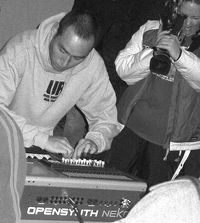
The last two panels took place on Friday June 4 and Mutek Artistic Director handled The Cultural Flow of Electronic Music with international panelists from Japan (Nao Sugimoto, Plop), Beijing (Francis Acquarone, 010 Productions), Mexico (Damian Romero of Imecamusic and Enrique Jimenez of Static Discos) and Columbia (Jose Plata, Encuentro Electronico). In this session they spoke of import/export issues from their respective countries, the high cost of promoting an artist across the globe, and the ease of connecting with others in the larger world community through the Internet. Romero spoke about the little context for electronic music in Mexico and how psychedelic trance seemed to be something that caught on. He joked about shows where 12,000 people would come to be mused by shows that were highlighted by graphics of monkeys burning petrol and acknowledged that what goes around comes around, and Mexico may be the last place to experience emerging movements in electronica, which gives certain phases and subgenres wider breadth, and longer shelf life. Though, this practice as he mentioned can also lead to the most well paid DJs, those with bling-bling, to remain popular and often the most interesting producers get lost in the shuffle.
Part of the disparity is due to having no historical context, even with a cultural center like Mexico City, the largest city in the world. In contrast, Tijuana is a tightly knit community as seen with the emergence of the Nortech movement dating back to 80s new wave and new romantic scenes, which can track the impact of the borders of two very diverse countries, and their influence on one another. A movement such as this helps Mexico get noticed internationally and creates a collective context for electronic music as a whole. In Columbia, as described by Plata, DJ culture continues to explode in the mainstream versus minimalism. “People are used to paying a lot of money to see a big DJ show, some for up to $100” he said. Given that the average worker makes approximately $300 monthly, using 1/2 of your income as entertainment dollars is something to be taken quite seriously. One local festival grew out of a small theater and now is a cultural center that encompasses and presents Latin music from Argentina, Chile, Mexico and other regions.
But the festivals, in many ways, have an 80s edge including big “guerillas” at the door, velvet ropes and all. Romero steps in to joke that “some DJ comes to play at a venue on a make shift, cheap wooden stage for $40 a head only to end his set after an hour and a half because he ate some chilis and became sick to his stomach while on giant screen TVs big commercial sponsor ads flash”. Sugimoto interjects that “foreign artists are seen as stylish” and so are seen as outsiders and that sometimes helps to sell tickets. The panel agreed that Uwe Schmidt really helped to open the doors of electronic music in Chile for a number of artists to which Mongeau nodded by saying that “Villalobos and Luciana are like hybrid products” of this expansion of musical possibilities. Sugimoto also was quick to point out that cultural difference and language barriers sometimes cause a disconnect as do import issues in and around licensing and laws like NAFTA.
The final panel was by far the most largely attended and whispered to be tres “controversial”. Although using other people’s sounds and ideas has been around long before even the Dadaists poo-poo’d it all, Sampling in Perspective moderated by XLR8R Chief Editor Tomas Palermo was definitely the contextually best discussion of all of the panels in the series. Palermo opened by discussing issues surrounding appropriation and interpretation and shared as a reading reference, a very good book by Mark Prendergast entitled The Ambient Century: From Mahler to Moby. He went on to discuss the tools that have made it even easier to shift, snip, cut-n-paste, crop and otherwise swipe sounds as the birth of devices from the home cassette deck, the mellowtron and emulator, Roland S10, Akai and many more up and through the advent of MP3 and other digital exchange. Palermo reminded us that in the bloated 1980s sampling “became a contentious issue” as the dawn of copyright litigation was coming of age. This led to the introduction of Mark Quail, a lawyer from Toronto who represents many recording artists including Stefan Betke (whose artist Jan Jelinek used Fatback’s “Wicky Wicky” recently). Also on the panel was John Oswald (aka Plunderphonics) whose been at sampling since the 70s, Jason Forrest aka DonnaSummer, Stefan Betke (Pole) and Matthew Herbert.
Oswald entertained with his outspoken style as he stood up at the panel table and had the soundman play some samples that he had brought and pumped up the volume. Forrest completely associates with some of the far most dire, overly used moments in 70s and 80s pop rock from the Cars to Neil Diamond to Slayer. He questions how one looks at the genre in the process of making music, how you break any barrier between prog-rock and disco and make it your own calling himself an “accidental musician” who once was a visual artist who then ended up on a 2-6AM radio show called “Dungeons and Dragons Revisited.” He is quick to point out that music is information, public culture.” In response Matthew Herbert (who himself designs sounds built from crumbling BigMac and Starbucks coffee containers), in one of the highlights of the session, heartfully discussed the loss of innocence, or call to justice in the defacing of public statements. Maybe with Paul Hardcastle‘s practical use of Vietnam era speeches aside, Herbert noted that Fat Boy Slim’s overplayed hit that used tag lines from a civil rights march blatantly mocked the passionate emergence of the voice of civil strife. A heated debate on morality ensued between Forrest and Herbert, both recognizing (I think) in the end that money is often the prime factor when it comes to making a quick hit with a recognizable passage, but they remained at corners over the “right” to use material at free will. The panel also discussed the ethical use of material whether it is recognizable or not, and the deeper more artistic reasons for what the use is all about in the first place. Copyright, trademark and intellectual property were discussed in their textbook versions. But what it really came down to was the ethical use of sounds that some have spent a lifetime learning to play and how quickly it can be scooped and reworked into new music effortlessly and sometimes without credit. The most interesting comment came from a portion of the talk that was excerpted due to time about balancing the differences between melody and harmony where Quail mentioning that “it would take a musicologist to help legally decipher between the two in what might end up being a rhetorical, open-ended question”. OK gentlemen, gloves off!
After the dust had settled a week later and the thought flow started to move like a beautiful stream of molten lava I had a chance to ask Forrest about his overall experience being on the panel and he had to say “I really loved that panel. Usually, when you participate in panel discussions like this, you are all used up by the end, and the discussion is most definitely over and talked to death. That particular panel, however, was the exact opposite. People kept talking to me in the days following saying that the dialogue continued in their own conversations. Certainly the dynamic of the panel organization is to be commended, because the inner turmoil of that particular panel was exactly the right balance for something really ‘right’ to happen.”
Like other international electronic music festivals such as Detroit’s Movement, Barcelona’s Sonar and Helsinki’s Avanto Media Art Festival – Mutek has become one of the few catalysts for experimental sound forms without exception. While other festivals jump full scale into drawing outside the lines and beyond the barriers of the multimedia aspects of sound in space, Mutek has increasingly focused on the emergence of digital communities formed through networks and delivered live, up close and personal, during these days and nights of sonic exchange. As an annual event this is for sure one of the most sought after, and still comfortably intimate festivals of its quality on the planet. So, here is an intimate reflection on this year’s events as they were delivered.
::..:::…..:..::….:::::..:::..:::::::……:::…::.:::….::::..:..:::…::…….::::

The first evening of performances was preceded by a cocktail party hosted by Misto Restaurant in the rear courtyard of Ex-Centris. The night was sultry, the beer was cold and the crowd of artists, music lovers and media had a relatively unified flow of anticipation throughout the foyer. This night was conceptually heralded as “minimalism vs. maximalism” and with the roster including COH (Ivan Pavlov) vs. Richard Chartier acting as a collective/competitive duo known as Chessmachine followed by Canadian audio/visual newcomers, Skoltz_Kolgen, anything seemed potentially possible. This evening’s performance took place under the roof of the steely contemporary architecture of the Cassavetes Theater, intimately seating 270 at Ex-Centris, a new media complex that houses cinema/theaters and a restaurant. Warming up the night was The Ceiling’s Antmanuv whose dense vibrations and skipped beats were warm and warped. The accompanying video of outdoor streetlights marred by movement with checkerboard tones was laid atop field recordings of truck motors that had an instant remoteness. With the insistent, repetitious sound play of propellers and multiple video layers he created the morph multiplication of a landscape by cycling metallics and pops in open air.
YOUR MOVE! Prior to when Chartier and Pavlov entered the stage it was already split lit with blue and pink lighting (a pun on gender/sexuality), two assistants placed color-coordinated flags on each side of a simple table that was set with opposing laptops which got a light round of giggling going from what otherwise may have been anticipated to be a rightful, gentlemanly game of chess – but as interpreted through music? And now, for their world premiere, Pavlov (blue) and Chartier (pink) came on stage in “team” color dress shirts and shook hands before they started. To the front of the table were official chess timers that each pressed as he completed his “moves”. An accompanying video that morphed between what looked like a brain barrier and a Pacman like chess game in progress entertained the eye as both men built sound structures in tandem. Pavlov created unusually brash and darkly tinged noise that flowed like blood coursing erratically, while Chartier started out quite methodical, like an engine purring around your ears in sensoround. Pavlov’s hollow tin, open and wide sounds were beefy in comparison with Chartier’s smoldering fire that burned fiercely like active hot coals like an imposing, sinister flash fire awaiting its rapture. Pavlov’s big sound rolled on like gigantic metal ball bearings with a crisp serrated static that caused a wired tone of feedback as if they were being bent out of maladjusted radio wires. The slow moving stencil of Chartier’s competitive nature began to emerge and flare in the next round as Ivan’s velocity only intensified to a squeaky screech with voluminous height. When Chartier took back control, and it did seem like a battle of pheromones, he punctuated his moves with a fire crackle to the countenance of Pavlov’s less rational, caustic industrialisms that weighed heavily on retrospective mid 80s hard noise, with a feral sense of humor. Chartier cautiously bided his time and fought back with a hailstorm of power static that blossomed fluidly and seemed impulsively generated by Pavlov’s anxious state of getting up off his seat and walking to stage left. In response, while Pavlov was developing quite a range of phone ring tones and erratic torrents of pop-rock static Chartier leans back to casually administer eye drops. Pavlov’s rumbling coaster leaves little room for silences and neither player in this game looks each other squarely in the face while they are playing. Like trained rattlesnakes, they both slither through raspy reeds and coursing pitch and relief. Until Chartier yawns and at one point both men end up on their feet with booming bass and drama. This is a game of precision and skill, and both players shall rightly be deemed the winner of this challenge. Mutek’s own record label simultaneously released a recording of the Chessmachine project and this work will be toured and further developed in the near future.
ANXIOUS PARALLELISM: Dominique Skoltz and Herman Kolgen make up the Montreal-based duo Skoltz_Kolgen whose “Flux:/Terminal v3.0” presentation was a live audio/visual triumph and by far one of the premium highlights of the festival. With a split screen of static sound and vision the players were pretty much morphed in front of the stage, like contemporary players at an old fashioned silent movie that was anything but silent. Their fast-moving and perfectly synched graphics were a rich visual barrage of skipping, muscular symbols, lines and various shades of vibrant light and densely deep darkness. Their field markers made math a myth in a moment with falling grids, they both tricked your ears in a way-making album cover art come to life on screen. The duo’s sonic coordination was seamless. The split screen merged into a single image with white on white overlaps, casting and shaping a post-post Warholian aesthetic styled by bold images bleeding into a completely digitized line drawing in space. They use an overt sense of minimalism (going back to the night’s theme) phasing all over the screen and into the room like a fourth dimensional sci-fi flick with tiny icons almost popping off the screen moving closer towards your perception and simultaneously following the spherical sound patterns generated from the two players illuminated only by the vague reflective light of their laptops. Could this be ghostly trash or visionary chaos? The mapping software they are using depicts a visionary ocean floor like a wayward architecture flawed by the nature of change (earthquake, etc.). Their driven bass was buoyed aimlessly in slow, maniacal/genius thumping strokes, in a watery fusion of microbes and other underwater surveillance guides and lost geometry. This is the future of sound.
::..:::…..:..::….:::::..:::..:::::::……:::…::.:::….::::..:..:::…::…….::::
Night two of Mutek took place at the Society for Arts and Technology (SAT) and included an evening that could be described as being a fusion of traditional meets futuristic directions in instrumentation and voice.
Opening with Montreal recording label Intr_version artists Vitamins for You, led by Bryce Kushnier, with two live players on trad-circus instruments like xylophone, an old fair accordion and a wonderfully forlorn guitar. Vocal is added to round the sound and offers a sort of melancholic electronica for the shoe gazing set, just a bit more of a bite than your average college radio fare – spicy yet muted. Their sound was immediately heartfelt and waxed poetically. Accompanied by video that looked more like a web banner with their logo interchanging natural objects and settings into morphing and splitting duos and quads. Their funky sould bass guitar faded in and away as they made a sort of distilled pop music that thrives on silly vocoders becoming in moments a reduction of Depeche Mode with the use of a sprite vocal chorus effect where the entire trio jammed harmoniously on cue. In the end Kushnier performed a solo minimal techno piece before exiting the stage for the entrance of Toronto’s Junior Boys.
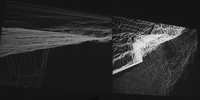
The duo of Matt Didemus and singer Jeremy Greenspan played with the inflections of funky, almost disco-soul guitar and vocal with a hint of both New Order and the Cure throughout. In general these KIN recording artists have an apocalyptic, slow-as-molasses sound, quite moody and spirited. Though not to be discounted as a genre wanna-be they use a mix of spunky toy synths alongside Greenspan’s soccer bloke frame – they look like your college buddies, but sound like something that could steal a Code-era Cabaret Voltaire riff on songs like the bassline-driven “Under the Sun” with its refrain “Like a child – let it own me..” dusted with a blurry synthetic piano and castaway attitude.
Next up for a longplay set were house favorites and Mute recording artists Schneider TM led by Dirk Dresselhaus with Christian Obermaier and Michael Beckett (aka kptmichigan) on guitar and cigarettes. When I saw them perform at last year’s Sonar I think the heat must have gotten to them (or maybe it was me) as it was in the 90s in a basement and the crowded house was filled to the brim. Once again the trio donned their signature chef whites to cook a storm in the ears of all in the house. Opening with a frenzy of drumming that played well to the red mosaic video that played as the backdrop. They were on from the first note, completely pumped for their live Canadian debut. They played ripping techno that built higher and higher and despite unobserved sound problems, Dresselhaus played to the sound technicians by singing “on the left side of the monitor” jokingly before straddling into their single “The Light 3000.” The song that takes apart the Smiths classic “There is a Light that Never Goes Out” crooning through a shrill vocoder that “driving in your car, you never wanna go home..” while taking on the dandy caricature of latter day Morrissey to a “heavenly” place! They made the course of vehicular death prettier than ever with their own blend of percolating rawness. Percussion is the core from which they rip into their songs like “Human” and others that dabble tightly into impersonating a great Pete Townsend hook at one moment while playing completely unintentionally into the mic feedback that finally got the attention of the technical staff behind the soundboard. They made technical difficulties work right into their overall sound with a sense of humor. Even as they introduced themselves at the end of the set Dresselhaus sounded like Chairman Kaga from the Iron Chef proving that popular culture should be observed (if not mocked politely) at any opportunity. Their set showed that techno music can be coy, sharp-witted and can rock!
Finishing the evening was Berlin’s Smith N Hack (Errorsmith and Soundhack) though due to the previous late night and much travel I apologize for ducking out a bit early, so please check your other local listings for what they designed and delivered to the hyped audience after Schneider TM whetted their appetites.
::..:::…..:..::….:::::..:::..:::::::……:::…::.:::….::::..:..:::…::…….::::
This early evening the border-crossing Windsor/Detroit Thinkbox Collective took to the stage for a free performance kicking off with curator and multimedia artist Mark Laliberte first up to offer his wares. His short set presented a sound that purred with ghostly shapes and a naked blue screen meditation. He, alongside other members of Thinkbox seemed to be working in a tandem, collective fashion throughout their showcase.
Christopher Bissonette‘s fade-in on stage was quiet and leisurely with a pulsating minimalism. His sound was esoterically ambient as he presented video of brilliantly simplistic double screens, mostly gray that faded in and out of darkness.
Then came Mark Theakston whose visuals poked fun at his tardiness of getting himself technically prepared for this performance as he was just days prior performing at Movement in Detroit. Over a glitchy, wavering beat he had prepared a number of text screens that were simply hilarious, explaining in a cheeky way that he was going to present something with flair despite his lack of tech time to perfect the accompanying visuals. In one of the few political moments of the entire festival Michigan’s Theakston took time to Bush bash and apologized on behalf of the US for the current status of terror threat and international relations with both a sense of doom and optimism. His shades of Negativland held a theme of contemplative angst as he took time to use lots of warm and fuzzyisms. It was actually kind of moving.
The quiet, contained guitar synthesis of strings and space made Bill Van Loo‘s appearance welcome from the start, though his video compliment was a fuzzed up black and white video surveillance tape looking piece that didn’t always coordinate peaceably with his playing. Van Loo’s clicky warp of drone was like the quintessential Tom Sawyer interlude past a wooden fence on a sunny afternoon and hitting every last spoke with a newspaper.
The larger, more dance-oriented sound of Steve Roy was a welcome shift from the previous material, though his use of bold drones balanced the meandering glitch-click pulsations snarling through the well-attended room. The overlapping black and white video of self-image was repetitive to a fault.
Saving the best for last, Chris McNamara delivered a set that was syrupy slow and prodding through a batch of paced beats. The complementary video of cityscapes and streets mirrored split screens of buses, trains and the people that travel on and around them daily. The streets of Barcelona were captured with undulating, sizzling, itchy sounds that ended the showcase like a fine elixir.
::..:::…..:..::….:::::..:::..:::::::……:::…::.:::….::::..:..:::…::…….::::
The atmosphere was prepared for a whole evening of stealth sounds and kicking the night off aptly was the shining light of the Montreal scene, David Kristian. Well known for his unabashed risk-taking and penchant for the darker side of what moves people he penetrated the room with a deep, buzzing void, a full half-hour of broad spectrum blur drone that he cordoned like a squeaky wheel of steel. Slowly over time burning out, breathing, and airing something of a fierce floatation above the seated space. His playing was chillingly eerie, taking hold of the body in a state of something a bit transcendental as if he was devising a way for a momentary transport to some ghostly hollow subway of concrete barrenness. It was, for sure, a zone-out session like a brazen, concrete tug of war.
Another one of the more stellar moments for sonic multimedia fusion at this year’s festival was the faceless a/v programmer/artist duo NomIg. presenting a single video piece called “PDX_01” which captured the powerful and gauzy-masked underworld of Darth Vadarian conquest with all the resilience of a post-Rauschenberg aesthetic. The smaller objects and gestures appeared on the screen, the more drawn the eye was to the unfolding mysteries that lay deeply sewn inside. It was subtle, effective and harkened to a soundtrack counting the end of days.
When asked about their overall impressions of this year’s Mutek in comparison with prior festivals NomIg. acknowledged “We felt that the Mutek programming was much more consistent this year throughout the entire festival. It was an interesting selection which had a strong focus on forms of electronic music which broke out of the classic Mutekien paradigm of the laptop musician playing Ableton’s LIVE by including a variety of acts who are most aptly described as bands. Part of the struggle for the festival, I think, has largely been a result of its success; what started out as a festival celebrating a very niche form of electronic music – and thus what made the festival totally unique – has been so successful that it is no longer a rarity to see and hear those electronic acts. The music scene has evolved quite rapidly (and I believe that Mutek was a catalyst for this) and whereas in the early years it was intellectually stimulating to stand and watch a laptop musician there has been an (overly, in my opinion) strong cry for a humanization of this form of music; a call for a return to performance and a need for a more direct form of musicianship. Thus Mutek kind of outdid itself through its success and had to grow. This year’s programming was a definite response to the community’s outcry, but what is important for the festival as an institution is not to meet the demands of the public but to dictate them. In 2000 Mutek was ahead of the game; now I feel as though they were playing catch-up to the public. Having said that, I do believe this year’s programming hinted at the future direction – namely the incorporation of audiovisual works/performances. If the organizers were to repeat its 2000/2001 success at being ahead of the curve, the upcoming years and especially 2005 will most surely have to have a very strong element of audiovisual artists represented. I am not referring to musicians who have VJs or a video track playing, but artists who work completely in the audiovisual domain; artists who compose audio and video simultaneously and equally.

This year Mutek certainly referenced the genre through the inclusion of Skoltz-Kolgen, the Rasters and ourselves. This, I believe, is a hint of what Mutek will need to do in the future. Five years is a very nice point to reset and reevaluate the landscape and I believe that a survey of this landscape most certainly shows a/v art as the next big thing. It is ironic because in many ways this means a return to the very origins of the festival when Alain Mongeau was programming the Media Lounge component of the FCMM back in the late 90s. So many things have converged since that time both technologically and socially that the fuse on the a/v explosion has already been lit.” And I could not possibly agree more.
As the night continued the fusion of continents came from New York/Vienna-based Mego recording artists Pure/Dekam (Peter Votova, Johnny deKam) as they took center stage. Their industro-chunky beat had a happenstance play with frequency with a residual buzz-static that went down quite refreshingly. As they played live their noise junket produced congruous images that lapsed to and fro from the aftermath of a Robert Motherwell exhibition in its use of bold and raw black and white imagery. Their sounds and sights were like unfamiliar fractals that were somehow used and filthy, but made perfect sense in the face of the depicted dank landscapes. When I asked Votova about the technical and artistic rush of it all he mused “At Ex-Centris we had simply the best technical conditions and cinemas are actually my preferred space for these kind of audio/visual performances, the whole situation was quite perfect. It was the first show for quite some time where I had enough time to prepare sufficiently and was therefore highly motivated – hope I was able to transmit this to the audience somehow….”
Finally the audience was treated to a solo set by half of Pan Sonic as Ilpo Väisänen entered quietly to produce an open sound space that was crystal clean, filtering optic nervousness into a morphing, merging, transformative set that burned from the inside out like one of those giant skyscraping implosions.
::..:::…..:..::….:::::..:::..:::::::……:::…::.:::….::::..:..:::…::…….::::
Rushing downtown prior to the previous showcase as not to miss a moment this evening had started out to be pretty unforgettable. Blessing the stage for the soon to be legendary set by the folks at Raster-Noton was the Belgian-born Montrealer and founder of the essential Hushhush label Szkieve (Dimitri della Faille). His video was a mix of mathematical writings and equations through x-ray printmaking as seen through steamed glass drifting off into the minimalism of a pitter-patter roadrunner beat. His low-fi, burnt out complexities with assorted mic pops were like a study in ancient penmanship concocting an amber/orange morphing organics.
The instant Raster-Noton co-founder Olaf Bender entered behind his laptop to perform as Byetone the entire room was focused, moving and surrounded by a steady warm bass boom that bordered every last body in the SAT space that evening. At once people familiar with his earlier work were probably wondering, who is this on stage? Though, his latest work on Binemusic attests to his wider range of melodic use of free beat and a solid multiplication of dizzy, funky body curves. The incorporation of dead-on timed black and white soft rectangular video images moved with every flicker of the mouse or keystroke. The steady swerving of unified rhythms caused for no sudden transitions, it was sonically perfect for live music. The dynamic video only bolstered his bold sound with filmic checkerboards and split drug patterns that were sanctioned by the radius of happy people. Bender operated under the jurisdiction of a post, robotic “Warm Leatherette” vision that seemed immediately possessed by the countless striations, breaks and variable lines and cuts he bathed the audience in.
Hail Perfectionism!: In an earlier casual moment between things that day I had taken some time to speak with Frank Bretschneider about his forthcoming performance and he confirmed that though he and his colleagues had been back and forth to tune and test the sound board with the Mutek technicians, that they had not gotten “exactly” what they were looking for. Well, that being the ultimate case, what they did get it was a perfect 10 (+ 1/2) to me. His demeanor as warm ad friendly as mixed into the sound of his set which opened with a solid line of sound, simple and linear. What started as a pure single sinewave signal slowly grew into a fluttering abstraction of shocking blue parallel lines with it adding crispy vinyl grooves, midnight bluism all the way. The flaming undertones of palpitated beat slowly drifted into the mix like a span of dna markers. The video design carried similar reflections that recalled police and other searchlights. The sound was undulatingly translucent, welcoming and hiding from the audience at different intervals. His timing reminded me of the work of the Japanese performance troupe Dumb Type whose precision is unmatched. During a second, shorter piece the work recalled an endless gaze through a bay window that held an austere dreamlike state, the visuals playing on every note. Lastly he blasted the audience with lush careening rhythms that were shockingly colorful as the room was surrounded with an interlude of stark red stripes and sunny yellow lines that drifted in some windy, cocooning beats and a tiny reprise towards the end.
Multimedia artist Carsten Nicolai performed a set as Noto and he ripped BPMs from the get go. Skeletal lines of synthetic, futuristic beats were driven ad infinitum. His boom-hiss-boom sound could be likened to something of a lively zen yoga in real time. The entire set was structured in bare black and white, like a TV broadcasting explosion where he was the controller of his own technical difficulties and planned to run with that as a theme. The work was steely and vibrant, danceable and reticent.
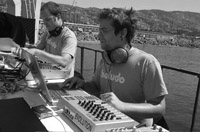
In the final round all three men joined together as Signal, a trio unit bonded in beat. There was no real way to tell who was performing what in this part of the presentation – it was a completely meshing, sonically charged, well designed post-man machine. Bretschneider said of the performance:
“I think this year’s performance was our best –after playing two times at the Ex-Centris cinema, we thought it would be better to perform at a more club-space like the SAT this time, and I think it was the right decision…our music became more and more rhythmic during the last few years and we had the impression people would like to move around instead of just sitting and watching the visuals…” I think the minds of Raster-Noton are correct in that prediction, as Jeremy, one fan remarked to Bretschneider “I would have to say with no reservation, that you were the highlight of this year’s Mutek festival for myself and a group of friends who came all the way from Seattle and San Francisco. The Signal performance was very maximal and an exciting new direction for your sound!” It was surely a night of asymmetrical sound magic performed before our eyes!
::..:::…..:..::….:::::..:::..:::::::……:::…::.:::….::::..:..:::…::…….::::
This late afternoon showcase of Montreal’s up-n-comers promised to offer a range of experimental dance music, though I was only able to catch Millimetrik due to cross plans and other commitments. Also included in this set were Mossa (Complot), Frivolous (Karloff), Martin Dumais (Hautec) and Mike Shannon vs. Jay Hunsberger (Cynosure/Revolver). Pascal Asselin’s (aka Millimetrik) deep-dark drone opened up a big wall of waves that glistened with a quieter reverb. Billowing like fly memories it carried an emotional weight like an indirect dream beat of bass sonics. His key element here was a slow simmering distance pushing the frontline softly away and capturing your interest in the sketches being created in the background noise. It was something of an invisible, semi-penetrable mirrored wall of eerie exclusion. While he played the room physically vibrated as he added shuffle rhythm tracks that were smack center of this cranking digistorm vortex. While crossing the lines of Dead Voices on Air, Millimetrik crossed the lines with a bit of what you might perceptibly hear on the Touch label (even if slightly derivative). The performance had a blazing impact, a midday mind meld body wrap. After the performance Asselin shared with me “my experience at Mutek was amazing. It was good for me as I’m a newcomer and was able to play in front of a larger and international audience. I think Mutek created a nice platform for both unknown and most known artists to meet, share and exchange ideas and music.”
::..:::…..:..::….:::::..:::..:::::::……:::…::.:::….::::..:..:::…::…….::::
The highly anticipated return of Novamute’s Ritchie Hawtin as “Plastikman Live 2004 (Kontrol)” was touted to be his first live performance in nearly a decade under this guise, and it was to be a rare and unique audio/visual extravaganza with an all night dance party that would then invite the Two Lone Swordsmen‘s Andrew Weatherall (Warp) to entertain the happy feet masses all night long! This long standing self-made artist/producer (Minus/Plus8) truly helped to put Canada on the international electronic scene map permanently and here’s how it unfolded:
Tonight, the sold-out Metropolis Theater, the largest venue of those in the festival, is a festive space. To begin, the show started about 90 minutes late (just before midnight), though, at first, the well-intentioned crowd didn’t seem to mind, and my own tardiness served me well for once. The large hall was packed with party revelers, clubkids and die-hard fans – many with t-shirts emblazoned with the quirky, squiggly graphics issued by the people of Plastikman. Once the lights went down the space was coarse with applause ans cheers as the curtain went up to reveal Hawtin at center-stage at a stark, futuristically outsized techno-consul of high-definition monitors suited for the occasion. Speaking of suits, Hawtin was very simply dressed in a slim black t-shirt and asymmetrical blond hair obscuring half his frontal lobe at times, the rest of his tall, slender frame covered by the works set up in an angular shape around his body. The set up was like a high-tech bar where Plastikman set off to serve up a potent cocktail to those ready to be nourished. But in some ways, from the start, it was more like a teasing IV drip, only giving his audience a part of what he had arrested in his arsenal of years.
The night started with a slow-fi rush of warmth, beats that were both steady and calculated. The video accompaniment was most disappointing as a static slow resolve that faded in and out of grey throughout his lengthy set. In his highly more mindblowing DJ set at last year’s Mutek he took to the stage with confidence and fervor and tantalized every last body on the open dance floor. This year there were less risks and rumors of extensive technical difficulties. But Hawtin, never to be seen sweating, made up for a portion of the faults by playing into the night. His trademark frenzy of lifting the vibe and keeping it in a stellar purgatory-like limbo state was intact, but not new from what had been presented on the very same stage the previous year. This was a bit of a recycle, watered down version of what our hopes may have been set up to experience, and there also seemed to be an unknown disconnect with the video material as it was anything but groundbreaking, especially in comparison with other events in this same festival. Though the inclusion of Plastikman-esque morphing blot tests (ala Rorschach) were eye-catchingly stark in a pure red against a black void. What Hawtin did produce was big club party entertainment, unlike the austerity and deep contextual lessons we have learned by his transformative records up to his latest “Closer.” The crowd here really has no room for compromise, they want their music to withstand the lowest common denominator and not get lost in the over filtering of a large venue sound spectacular. Hawtin’s performance would likely have fit into a burgeoning club set in Ibiza, London or New York, but it did not end up to be what was planned. I guess you should only expect the unexpected.
Andrew Weatherall‘s totally-on spin cycle had a smaller, yet still huge crowd, dancing ’til dawn…or actually with the prior performance and its lateness was discounted only by its own curfew. That did not stop anyone from having an amazing time. The volume seemed to be a few notches shorter after Hawtin left the stage, but Weatherall pumped his sweat into well selected (and obscure) cuts that were familiar yet understated and his years producing the light of the Sabres of Paradise only helped to drove the fueled bodies until the lights went up around 4AM.
::..:::…..:..::….:::::..:::..:::::::……:::…::.:::….::::..:..:::…::…….::::
An international afternoon set was quite welcome as the week came to fine climax of vibration and looping insanity with players from Chile, Finland, Germany and the UK but first up was a meeting of the highly viscous minds and acoustically swelling anti-formula of Montreal’s I8U and Magali Babin. In the murky haze of a giant drone of reverb two women stood facing one another at dueling laptop decks filling the space with formidable electricity. At the start they started the process of adding small bits of white noise into the levitating rumble mix. It glowed and purred to a boiling point. They shifted volume as a waft of organic particles drifted in space like spheres. These craggy elements sped by your head estimated no slower than approximately 80MPH, a continuous rush of pulsing reverb energy. Still, serene somehow in its blatant, peripheral big black cavity of low-centered, industrial collage. Of her performance I8U remarked “Since Magali and my performance relied heavily upon improvisation, the setting played a major role. Artistically, I felt we brought together two diverse experimental styles and achieved a complicity and form that can be taken as one.”
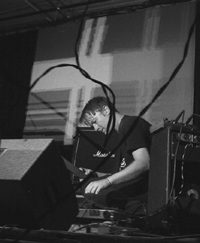
Brandishing a guitar and nerdy spectacles, the chain-smoking, song-based, techno-rock, abstract world of kptmichigan (Michael Beckett) came to life in a flash. Yeah, it was like that…a mouthful, and with wiry vocoder gymnastics he came crashing to the stage scratching his head as he drove the pulse of rhythm to a fever pitch that just rocked! With wobbly guitar Beckett provided a latter-day Breeders-like feel with a clunky, evolved aesthetic, wiggly knee and all. The 0s and 1s of his black and green IBM visuals provided an industrially neutral backdrop that mingled finely with the open mixer crunch-drone that provided an intentionally live sound, releasing his inner-Beatlemania sound. With nervous flare he rocked with frivolous pop underpinnings that were categorically infectious as if he was channeling the Ramones vs. Merzbow as broadcast on AM radio!
Rumblephonics! By the time Bip-Hop artists Angel appeared the now fatter audience was entertained and bushy-tailed but probably had no idea what they were about to endure. Schneider TM’s Dirk Dresselhaus and Pan Sonic’s Ilpo Väisänen make up the sound sculpting duo presenting their North American first live performance. Towards the start they offered a soft and slow calm before the eye of the storm alarm call, something that could have been a pending threat but not obvious to the earwitnesses in the house. With the prepared guitar and crystal clear mixer that produced a intimidating hollow, steely treble a rumble of percolating noise was about to take hold of the mass before them. The guitar rumbled like metal gods caught in their wires. What came next could only be described as the frontier of fire where they unleashed a voluminous cast of noise that was loud enough to make you laugh a bit uncontrollably, especially if you were sitting front and center like I was in that relatively contained space. It was a dose of Iron Maiden on speed, a Molotov explosion in testosterone tinted quite darkly. If you were not wearing earplugs it may have hurt your eardrums some. They brought the tempo and levels down a bit to offer a doomy house track that was hidden amid bass congestion as Dresselhaus used something resembling a vibrator to upgrade the sonic possibilities. A threatening growl of noise ensued and the thrill seekers united. The next thing I noticed were small specks of white paint courtesy of the ceiling and later I joked with them about how they had literally blown the roof off the mother, we all broke out in laughter. It hurt so good!
The glitchy newsreel, post post techno of Errorsmith (of Smith N Hack) had on hand a bastion of off-kilter dance beat. His live set ran speedy, stumbling and back up again the sound kept trying to catch up with itself. Without a blinkits faults became the primal engine it was fueled by. He presented the work in segments like separate tracks which sounded a bit like he was gaming for the audience. The zooming loops and joystick tweaking coming from Errorsmith’s tools poked fun at a club sound while making it deep, real and yet perforating the beats with humor. His result flailed oddly with a tongue-in-cheekiness, a sorta “put the needle on the record” syndrome without a cure.
Portable is South African-born Londoner Alan Abrahams, the dreadlocked discovery of this showcase. In his North American debut his direct style took funky rhythms to a newer, cleaner place. With a simple set-up of a laptop and small mixer he created atmospheric overtones that danced in space before our eyes. These suspenseful jams curatorially stuck out randomly here and had a bigger sound than the room was able to accommodate even though this was not the same neon crowd that had stuck around to see Hawtin’s show night’s earlier. Portable made the necessary, reasonable accommodations to size his music for the space, though the outside walls of the SAT are probably still shaking, tongue-n-groove, to this day!
With an all-nighter ahead I slipped out for some nourishment prior to the staging of what would be this year’s sole interpreter from Chile as Tigerbeat6 artist Original Hamster reportedly gave the audience a playful bridge between dancing and thinking about it.
::..:::…..:..::….:::::..:::..:::::::……:::…::.:::….::::..:..:::…::…….::::
After being frisked for drugs, told that I could absolutely not use my camera, and otherwise made to wait quite a while in line before entering the Metropolis for this Saturday all-nighter I felt like I was a puppet in a rave production for later broadcast on CNN. That inconvenience aside I settled somewhere towards the front of the balcony knowing I would need all my magic stamina to see as much through as possible knowing that re-admission was inadmissible.
Static Discos artist Rubén Tamayo as Fax represented Mexico as an emerging sphere of electronica. Starting off with a spatial mix of ambient, pure bubble beat he kept the house in a slow simmer and with a bassy thud brought things alive with a high hat and lots of ooo la la. The night’s video was cast as a giant mosaic on 16 multiple panels and his backdrop was a montage of a cityscape delineated by lines acting as rails on which images, or portions thereof moved. The effect was something ala John Baldessari with random red dots appearing in portions unexpectedly obscuring parts of the broken image. A second set of like panels were hung around the periphery of the balcony. Tamayo’s consistent, quality beats were continuous and spiced right with a shuffle and shift in volume that created its own version of ethereal smoke rings at a higher range.
Mutek brought back their hometown duo Egg again this year to celebrate their latest release on the Mutek_Rec label. As DJs they created a lively, almost dayglo sound that was complimented by a quirky Warhol meets Monty Pythonesque video. They overlapped upbeats that bobbed generously as they jammed. In a phrase it could be called stadium hypnosis punctuated by silly situations where children point broken fingers at one another on screen. The audience was engaged and dancing as they stretched their set into an ever increasing pixilation. Chunky and colorful, Egg’s sound added peripheral calypso beats and an astonishing big band flair that just pumped up the rhythm into a smooth sound that stole the show.
Rump Bump: The welcome return of Playhouse’s reclusive Isolée (Rajko Muller) brought a pop-club rock sound that was as distant as it was dark and delicious. His sound is like a big Cadillac warming up in Winter, a heavier vibe explored by space aliens invading out planet. The work and its visual components were like reflections of landscapes that just kept morphing seamlessly into one another. France’s Krikor chose to offer a predominantly thumping selection of sounds that were overly beat generated with the formulaic gravity of Kraftwerk and an aggressive uppity tone that ripped into a rubber beat of 100% pure bass.
AIN’T NO PARTY, NO COCK ROCK DISCO!: Dressed in a dapped white dinner jacket with tails Jason Forrest (aka DonnaSummer) also donned a black t-shirt with some imperceptible rock slogan emblazoned in cubic zirconia across his chest. His “wake-up mutherfuc*ers” styled welcoming address was all of the bling-bling rock spectacle you’ve grown accustomed to, only this time on his spliced and diced terms. Called by some a “sample terrorist” but I will politely refer to Mister Summer as a fallen star that landed in the center of some serious shit and whooped it up big time! He’s like a big kid whose addicted to his old, tiny Panasonic tape deck where he’s gone off and tied the ends of the world’s worst possible 70s AOR rock. Then he blatantly recycles it every potential way he can muster fusing the worlds of Styx, ZZ Top and Talking Heads (“this ain’t the Mud Club”) effortlessly to no end – and adds his own pungent noisey hooks and sped up frenzy of bulleted, belligerent bally-ho. Barely behind his Mac for much of his performance he lap-synched by prancing around all Animal Housian noting coyly that “Akufen is in the house” and mentioning that he would be “giving out handjobs afterwards…” Or that’s what I “think” I heard. His coreless thrash-punk techno rock was a sampledelic, no wave tip o’ the hat to Negativland and all things Plunderphonics with extra beats.
When he announced he was going to play a piece of folk music, noting that “I hope you like it, I do” he then ripped into something that peculiarly matched the likenesses of Fleetwood Mac against a hardcore backlash of Sabbath Bloddy Sabbath all along miming the “ww-hoo” vibe of one of Alanis Morissette’s more twee singles. All through his flash set Forrest basically paraphrased his latest Sonig platter “The Unrelenting Songs of the 1979 Post Disco Crash” – ahem. In the end Forrest was barraged by spectacular applause and booing hisses. He certainly had heads turning curiously and broke up a night of deep dance rhythms in a way that cleared patches of the floor and gave some of the crowd a chance to visit their favorite bartender. Though beyond the spectacle is a man who went from the page as a visual artist to the stage as a truly virile, live performer with guts and attitude. More than just this year’s answer to say, Jamie Lidell, there is a fervor breaking the barriers of the live performance and these gentlemen prove that this is just the beginning of a wild future.
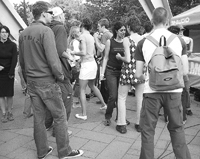
Barely much wind left in me circa 4:00AM or so the Golden State’s Rip Off Artist (Vertical Form) who heads the expanding Inflatbl label did his best to merge a batch of my wildest interests by playing sounds that were frightfully groovy, yet ingenious in an almost scientific sort of way. In fact, if you were to play his records simultaneously you may decode some of the deepest secrets of Graceland. Though don’t scratch the surface too deeply, let Matt Haines lock the grooves for you. This was house music for ultra-moderns. Crackhaus (w/Scott Monteith aka Deadbeat) and Matthew Herbert rounded off the wee hours while I walked with a few friends towards breakfast around 5AM (where someone had carelessly left Extasy behind on the table) with one eye half open and a fluttering heart rhythm distilled in a harnessed recall of a night well spent. I do not remember the crepe, but the beat was live inside me.
::..:::…..:..::….:::::..:::..:::::::……:::…::.:::….::::..:..:::…::…….::::
Mutek held its first Piknic Electronique in the Parc Jean-Drapeau on a beautiful Sunday afternoon overlooking the magnificent Montreal skyline! When we arrived around 5PM or so a DJ was spinning, the previous night’s revelers were dancing to the more chilly beats and people like Ritchie Hawtin and others were spotted in the wake of folks who turned up to celebrate another year of great music. There were fruit smoothies, shirtless buff dudes, cool shades and a speckle of media folks and private picnics all around the periphery and under the largely erected metallic “Man” sculpture. Kind of embellishing the spirit of community forged at this annual event, Alan Abrahams (Portable) who attended the Piknic had this to say: “On the Sunday at Mutek’s picnic a little girl, must’ve been 9 or 10 came up to me and asked if I’d be live that day too as her mother said she should hear my music, she pointed to her mother on the other side of the square…I said unfortunately not, but was quite moved…then later she came up to me and handed me her mother’s business card and asked if I could please email them ways of getting hold of my releases, which I did…”
::..:::…..:..::….:::::..:::..:::::::……:::…::.:::….::::..:..:::…::…….::::
The finale offered a large assortment of talented steadfast musicians that speak in velvet tongues of fire. Vancouver’s answer to the evolution of Chain Reaction is Kranky artist Loscil whose third album continues to bring a certain sparkle to the hiding art of introspective ambience. Scott Morgan is one of those rare musicians who bares his soul pretty plainly with its assortment of pains and permutations. His sallow dub along with a uniquely live, sense-surround approach to the material brought to life, in the fourth dimension, some of his most subtle compositions. The performance was embracing yet erasing, all the movement beyond the immediate space that is. Most reclined to take in the cerebral palette of muted, interpretive colors Morgan assembled, drifting above and away.
The legendary drummer Jaki Liebezeit of Can joined recent colleague and Nonplace honcho Burnt Friedman along with proto-guitarist Joseph Suchy (Whatness, etc). It was a variety-pack clash of heady entrepreneurs of advanced indie-electronic sounds. And the beat goes on….as they played true structures, sound signatures that were like a trad jazz set without any trappings or unnecessary encores. They drove a synthesis of guitar, drums and synth/mixers to sculpt out bridges, riffs and other tumbling visualizations that were pleasingly weird, and yet somehow familiar. The live presentation was not about rocking out or impressing with haircuts and glitter, they created live track after track to individual applause and their own independent pulse of improv. And only once or twice did I notice them looking towards one another to find their place in the music. They created a warm steam without blowing the top. Other later evening presenters included Ghostly’s Geoff White & Ben Kamen, The Mole and the irrepressible Jamie Lidell’s 1 Hour Fiasco which was plugged to be a videogasm of sorts (but I heard it was a bit of an earthquake)! After his live performance at Sonar last year I am still reeling – don’t miss this guy if you get the opportunity.
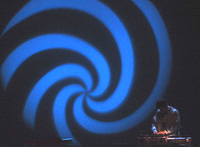
When asked if something at this year’s festival blew her socks off France (I8U) said “This is like telling a kid in a candy store you can pick whatever candy you like!…among my favorites this year I would have to say, Chessmachine, for their innovative concept and its execution, Skoltz_Kolgen who continue to amaze me with their vision and precision, David Kristian for a beautiful cinematic set, Pure/Dekam, Angel, Jamie Lidell and for me, “la pièce de résistance” being Burnt Friedman & Jaki Liebezeit.”
I asked NomIg about their work in the context of the festival and how it felt to be the primary artist exclusively represented in video form, and about how they feel the work brings digital music beyond performance. “It was slightly odd being the only artists to present a work that was not performance based. I think in some way the fact that it was not a performance but was presented amongst performances was quite confusing for the audience and may have gotten a little lost in the mix, so to speak. It was also quite short which didn’t really facilitate the audience understanding that a switch in presentation method had occurred, as, by the time this was clear the piece was over and we were back in the performance paradigm again. The irony of this, of course, is that all this was presented in a traditional cinema setting. And that, I think, belies the true multidisciplinary nature of MUTEK and Ex-centris programs which is fundamental to the festival’s mandate. For us, both when we perform live and when we created this piece, we feel it vitally important to capture the essence of the cinematic experience. We also try to fold in a more musical approach to this experience, without ever actually tipping the balance one way or the other. Technically when we create and perform, we use the same methodology for both the video and audio aspects. All of this to say that we are very interested in blurring the distinction between the forms of cinema, music and video.”
And so, another year noticeably passes into the midst of memory and those who were there will take with them experiences that were in many ways one of a kind. Those who missed it, well, you did! Here’s to v.6!!!!!
::..:::…..:..::….:::::..:::..:::::::……:::…::.:::….::::..:..:::…::…….::::
A great way to document a festival is to include music for the masses, and Mutek does an outstanding job this year by offering some incredible tracks from the participating festival artists, some even unreleased to date. This year brings a double disc set that is aimed to please, with a particular focus on sounds that are heavier on the beat cycle. Geoff White’s (Aeroc) ‘Soflo’ bathes in the warmest glow of Summertime rhythms (just watch for his new “Viscous Solid” on Ghostly soon). Part lounge slither and just lazy enough to be the soundtrack for asking someone to bring you a tall glass of freshly squeezed limeade, Aeroc straddles a bass groove and rides the curves. Static Disco’s Fax takes things up and ‘Et cetera’, but just a micro-meter, harnessing a limbo-beat that stimulates and remains fiercely fixed. The repetition is itchy and gives credence to terms like “microhouse”.
Montreal’s Egg offer a new cut called ‘Presque bleu’ an upbeat jazz meets b-side outtake. This is music you can play with, its like tricky disco. Frivolous samples the swing era with a clicky playschool version of prime Louis Prima as seen through a well-worn frat house spaghetti strainer. His ‘Kisses (in Swing Time)’ bites and bends with a rubbery lipped vocalist who sings the distorted American dream about “me n’ my wife workin hand and hand to have a good life”. Mossa’s ‘Giant Footsteps’ aren’t so giant…they’re actually kinda creepy, to a shuffle beat. But don’t let that scare you, he actually channels Yoda’s deepest rainforest in the still of the night as the tracks saunters and otherwise builds a crunchy harmony real slowly. Is it Depeche Mode run through a meat grinder, or am I on the glittery staccato stage of Soul Train? No matter, it’s just Jason Forrest (the artist formerly known as “donnasummer”) and he takes his jukebox of quickie clips and big-ass jams to the ears of a whole new generation of nerdophiles. Couldn’t tell you where the samples came from so I recommend that you whip it good! ‘The Auctioneer’ (with bonus yodeling) is all yours from the mind that is sunny California’s The Rip Off Artist. It’s a mélange of junk culture jive with a slapping backbeat, get on!
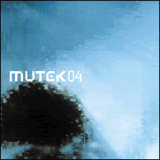
The edit of Trendsetter and the Followers’ ‘Powerpoint’ reminds me of the latter days of disco when new wave influenced everything from the way heels glided, shimmy bags shone and much mascara ran. This Original Hamster has a flow and cute vocalese that recalls everything that was flippant about the intro to electro. Give me Portable’s ‘Aphrodisiac’ and prepare for impending transport, as its beat guides you in slow motion to the farthest ring of uncharted space. Frank Bretschneider’s ‘Barebone’ uses pitch and variable time to sketch a piece that could be only possible by way of neon laser light. It demystifies minimal music by breaking down and apart the hiss and click in the everyday, acknowledging there is rhythm all around us, from the sounds made by toys to a Peterbilt backing up in the suburburban driveway. Taken from the film of the same name The Mole’s ‘Chop City’ and its finger snaps pretty much attempt to blur the lines of something experimental, but its really a wannabe dance track in the body of something quite muddy. Vitaminsforyou offer the really well produced ‘Six o’Clock Whispers’ that is destined for radio play. They cross electronic music with something you might hear in a Gap commercial, just holding a thread too close to its introspective qualities to break out further – it stretches with a funky freedom without selling out too large.
Disc two starts up with Carsten Nicolai as Noto and his track ‘Pulse xs’. It’s a live wire, marshmallow batter mix that stunts your ears with an effective open electric buzz. A perfect segue is Pure’s ‘2d3’ that revs up some much needed broad bass, plain and simple. As the longest track on the compilation at just over 12 minutes, it just wraps around the listening space, widening and adding some sparse high-pitched tones in the center channel. As the din luminously hovers there appear to be any number of immaculate, industrial mirages phasing in and out from multiple angles. This one needs volume.
Chessmachine (Richard Chartier and Ivan Pavlov) strategize electronically with ‘Moves 1-2’ (others can be heard on the just out full-length studio recording on Mutek_Rec). Chartier’s big moves seem quite distant and fluid compared to Pavlov’s more irritably scratchy lead into open air feedback and bubbly bridge. Heady, maximal minimalism that is just quite physical comes from the generators of Skoltz_Kolgen. Their track ‘üux_underscore’ is possibly a prequel to their live presentation at Mutek. Hollow windy drone and frenetic electronic errata scales the space and fades sinuously. A sensuous air stream of static wind continues with a greyer forcefield in ‘1/4’ by I8U and Magali Babin. Excersize your eyelids, drift off in restless bass with loose ends. From the Mermaid Room emerges David Kristian with ‘Amaya pt.2’ a queasy, modern day air raid.
The Raster-Noton trio (aka Signal) team to envelop our brain with the standout track on this comp, ‘Spiral’. In mid-teleport my synch-code is jammed, but without access it may be a failed surveillance mission…yeah, it’s something like that…just much more rhythmical and harder than steel. ‘Oysters’ drop from the sky bucket into the arms of a duo Angel who just happen to be comprised of parts Schneider TM and parts Pan Sonic – so how could you fail? The Bip-Hop artists’ piece is something of a weary-eyed roulette wheel that’s been manipulated by the stop-starts of a simple tape machine, only the percussion sneaks through with a driven guitar pick-up in waiting. It plays like drunken moles searching for Brie.
Thinkbox’s Steve Roy lends his own techno hybrid on ‘Transformation’ to this collection with a track that is sure to stir your libido to drive to a higher form of movement. Zip-a-dee-doo-daaaahhhhhh, it’s kptmichigan’s “Mountain Music a” and it’s an inebriated majesty’s request (in reverse of course). Its strings are loose and proud. The Warp(ed) Jamie Lidell takes less than two minutes of our time to conclude (as he did the Festival, under raucous conditions) the proceedings with the overtly anxious miasma of sponge-bob-technohardcore-superplunderphonics(expialidocious)ness on his live (ahem) ‘Scrapplonius Chunk’ (lol). With 28 tracks in all this collection also includes tracks by Loscil, The Mole, Antmanuv and others.
::..:::…..:..::….:::::..:::..:::::::……:::…::.:::….::::..:..:::…::…….::::








